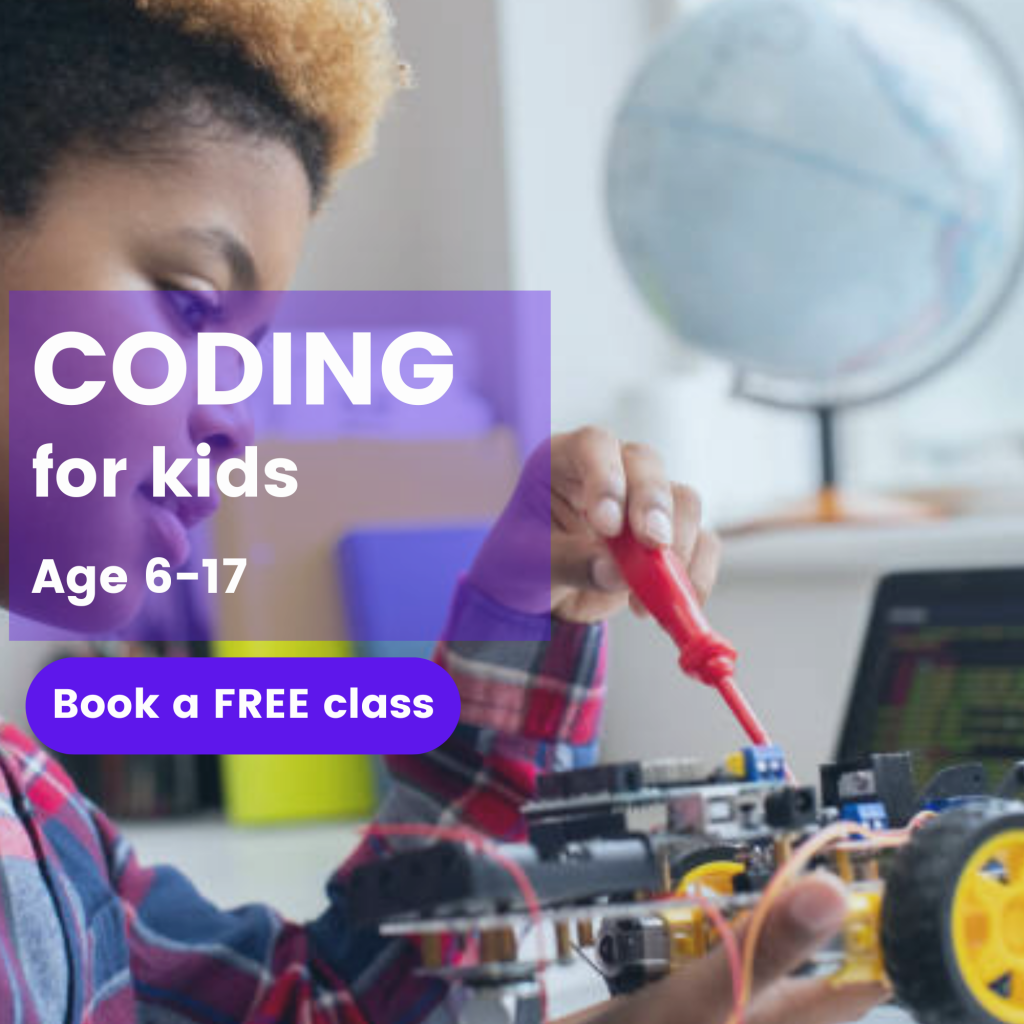All you need to know about Coding Classes for Kids: Which One is Right for Your Child?
Are you a parent looking for the best coding classes for your kids, or looking to understand everything about coding for your kids, then this article is for you.
Introduction
Definition of coding classes.
Coding classes are special courses designed to teach students how to write software applications using a specific programming language. These classes enable learners to acquire essential coding skills and knowledge required to build computer programs that can perform various tasks, solve problems, or create innovative technology solutions.
With the increasing demand for tech-savvy professionals, coding classes have become an essential tool for many aspiring programmers, software engineers, and developers. Today, coding classes exist in various formats ranging from online platforms to in-person classes, workshops, and boot camps.
In most coding classes, students start by learning basic programming concepts such as programming syntax, algorithms, and data structures. Then, they progress to more advanced topics such as object-oriented programming, web development, and mobile application development.
Coding classes come equipped with a range of features that help students learn to code effectively. These features include hands-on coding exercises, peer-to-peer interaction, and instructor support. Moreover, coding classes provide learners with a project-based approach to learning, where students work on real-world coding projects to gain practical experience.
Generally, coding classes cater to learners of all levels of expertise, from beginners seeking to learn the basics of coding to experts looking to hone their skills further. Overall, coding classes have proven to be an effective way for anyone interested in coding to learn how to design and implement code that can bring ideas to life.
Importance of learning to code
Coding has become an essential skill in today’s digital age. It is the process of designing, developing, and implementing computer programs. With the advancement of technology, coding has become an important aspect of various fields, from app development to engineering, data analysis, gaming, and more. In the blog section, we’ll explore why learning to code is important.
1. Coding Promotes Problem-Solving Skills
Developing a program requires a structured approach to problem-solving. It helps identify the problem and break it down into smaller, more manageable components. Through coding, learners can develop critical thinking by finding innovative solutions to a problem.
2. Improved Creativity and Innovative Thinking
Coding is one of the most creative fields that entails constant learning and experimentation. It requires creativity to develop innovative solutions to a problem. Learning to code helps in promoting creativity, empowering learners to think of fresh ideas that can impact the world.
3. Coding Enhances Career Prospects
Knowing how to code opens up new career opportunities in industries like software development, web development, app development, and much more. With the increasing demand for skilled professionals in the tech industry, including coding in your skill set can enhance your career prospects.
4. Improved Communication & Teamwork
Coding is not a solitary process. Software development requires working in teams, and effective communication within teams is crucial to the success of a project. Learning coding skills enhances communication skills and teaches learners how to work together to achieve a common goal.
5. Boosts Entrepreneurial Skills
Coding is the foundation for tech startups, and knowing how to code is essential for entrepreneurs with tech-based business ideas. Building an app, software, or website, involves coding. With coding knowledge, entrepreneurs can develop products and launch their digital ventures independently.
In conclusion, learning to code is an excellent investment for anyone who wants to enhance their professional careers, gain essential problem-solving and creative thinking skills, work in the tech industry, or start a tech-based business. Don’t miss out on the opportunity to learn to code as it can open up new doors of opportunity for you.
How to find Age-appropriate coding classes for kids
As technology continues to advance, learning how to code is becoming an increasingly important skill. For parents who want to introduce their children to coding, it’s important to find age-appropriate coding classes. Here are some tips:
For ages 5-7:
At this age, children are just beginning to understand basic concepts like cause and effect. For coding classes, you’ll want to look for classes that focus on introducing coding concepts through fun games and activities like coding robots. Children can learn coding basics like algorithmic thinking, sequencing, and debugging in a fun and engaging way.
For ages 8-11:
For this age group, children can focus more on structured programming concepts while still learning in an engaging and interactive way. Kids can learn programming languages like Scratch or Python to build simple games and animations. Classes should focus on the basic concepts of programming, such as loops, functions, logic, and events.
For ages 12-17:
For older children, classes can provide more in-depth programming knowledge in various languages, such as JavaScript or C++. By this age group, children can focus on the visual aspects of programming, such as web design, or continue to develop games and apps. You can look for classes that teach the fundamentals of coding, data structures, and algorithms, which will help children learn how to program in general.
In general, coding classes should be interactive and engaging for children. Immersive environments such as Minecraft, robotics, or game design can make for an engaging experience, and using these platforms can help children connect with coding concepts. However, it is important to remember that not all children will have an interest in coding, and it’s okay if they decide programming isn’t for them. Finally, be sure to consult with a qualified coding instructor for expert guidance on age-appropriate coding classes.
What are the Benefits of coding classes for kids?
As technology continues to advance and play an increasingly important role in our lives, coding has become an essential skill that kids can benefit from learning. With the rapid pace of technological development, coding knowledge is becoming more valuable in almost every field, and it can provide kids with a foundation for success in the future. Here are some benefits of coding classes for kids:
- Develops problem-solving skills
Coding teaches kids to approach problems in a logical, step-by-step manner. They learn to break down complex problems into smaller, more manageable parts and use critical thinking to develop solutions. These problem-solving skills can be applied not just to coding, but to any situation in life where a solution is needed.
- Enhances creativity
Coding classes also encourage creativity in kids. Through coding, they can bring their ideas to life by designing and creating their own games, websites, and apps. It allows kids to think outside the box and develop unique solutions to problems.
- Improves Math Skills
Coding involves math concepts such as variables, geometry, and algebra. By practicing coding, kids can improve their math skills without even realizing it. As they learn to code, they will understand mathematical concepts and the logic behind them in a practical, real-world context.
- Boosts Confidence
Coding classes provide kids with a sense of accomplishment and boost their confidence as they learn new skills and create projects. As they develop their coding skills, they become more confident in their ability to tackle new challenges and solve complex problems.
- Prepares for the Future
As technology continues to advance, coding skills are becoming increasingly valuable in the job market. Learning to code at a young age can provide kids with a foundation for success in the future. They will be better equipped to take advantage of the opportunities that arise in the tech industry and beyond.
In conclusion, coding classes for kids provide numerous benefits that can help them develop valuable skills for the future. By teaching problem-solving, enhancing creativity, improving math skills, boosting confidence, and preparing for the future, coding classes can be an excellent investment in your child’s education and future success.
Different coding languages for kids
There are several coding languages that are suitable for kids to learn. Here are some of the most popular ones:
- Scratch
Scratch is a visual programming language designed specifically for kids. It features a block-based programming system, where kids can drag and drop blocks of code to create their programs. Scratch is widely used in schools and coding clubs for kids and is suitable for kids as young as 8 years old.
- Python
Python is a popular general-purpose programming language that is used by professionals in various industries. It is also a great language for kids to learn because of its simple and easy-to-read syntax. Python has a large community and a vast library of resources, making it a great language for kids to learn independently.
- JavaScript
JavaScript is the language of the web and is used to create interactive websites and web applications. Kids can learn JavaScript to create games, animations, and interactive websites. It is also a great language for kids who are interested in robotics or Internet of Things (IoT) projects.
- Ruby
Ruby is a user-friendly programming language that is easy to learn and understand. It has a simple syntax and is known for its focus on simplicity and productivity. Ruby is a great language for kids who want to learn web development, create games or build their own applications.
- Swift
Swift is a programming language used to create applications for Apple devices. It is a beginner-friendly language that is easy to learn, and is great for kids who want to create their own iOS applications.
In conclusion, there are many coding languages for kids to choose from, and the best one depends on the child’s interests and goals. Scratch is an excellent language for beginners, while Python and JavaScript are great for kids interested in more advanced programming. Ruby and Swift are great choices for kids who want to create web applications or iOS apps. Regardless of the language chosen, learning to code can be a fun
Choosing the right coding class for your child
Coding classes for kids have become increasingly popular in recent years, as parents recognize the importance of teaching their children valuable tech skills. However, with so many coding classes available, it can be challenging to choose the right one for your child. Here are some tips to help you choose the right coding class for your child:
- Determine Your Child’s Goals
Before choosing a coding class for your child, it’s essential to determine their goals. Do they want to create games, build websites, or learn how to program robots? Once you know what your child is interested in, you can choose a coding class that aligns with their goals.
- Research Different Coding Languages
Different coding languages are suitable for different types of projects. For example, Scratch is an excellent language for beginners and younger kids, while Python is suitable for more advanced programming. Research different coding languages to determine which one is best for your child’s goals.
- Check the Instructor’s Qualifications
Make sure that the coding class is taught by a qualified instructor who has experience teaching children. Look for instructors who are experienced in the programming language your child will be learning and who have a teaching style that matches your child’s learning style.
- Check Class Size and Structure
The class size and structure can have a significant impact on your child’s learning experience. Look for classes with small class sizes and a structured curriculum that covers the basics before moving on to more advanced topics. A good coding class should also provide opportunities for hands-on practice and project-based learning.
- Read Reviews and Testimonials
Before choosing a coding class, read reviews and testimonials from other parents and students. This can give you an idea of the class’s quality and the instructor’s teaching style. You can also ask for recommendations from other parents or your child’s school.
In conclusion, choosing the right coding class for your child is essential for their success and enjoyment of learning to code. By determining your child’s goals, researching different coding languages, checking the instructor’s qualifications, checking the class size and structure, and reading reviews and testimonials, you can find a coding class that is the right fit for your child’s needs.
Tips for Parents to support their child’s coding journey
As a parent, supporting your child’s coding journey can be both challenging and rewarding. Here are some tips to help you support your child’s coding journey:
- Encourage Your Child to Experiment
Coding is all about trial and error, and it’s important to encourage your child to experiment and try new things. Encourage them to take risks and try out different coding projects to find what they enjoy.
- Provide the Right Tools
To support your child’s coding journey, provide them with the right tools. This includes a reliable computer or tablet, a good internet connection, and the necessary software and hardware. Consider investing in coding books, coding games, and coding courses that align with your child’s interests.
- Make Coding Fun
Coding can be challenging, but it doesn’t have to be boring. Make coding fun by gamifying the learning experience, setting achievable goals, and encouraging your child to collaborate with other young coders.
- Celebrate Their Successes
Coding can be a challenging and frustrating journey, so it’s essential to celebrate your child’s successes. Celebrate their milestones and progress, no matter how small, and acknowledge the hard work and dedication they put into their projects.
- Find a Supportive Community
Connecting with other young coders and their parents can provide valuable support and inspiration for your child’s coding journey. Look for coding clubs, online communities, and coding events that your child can participate in.
- Support Their Learning Outside of Class
Encourage your child to continue learning outside of class by providing them with additional resources and challenges. This could include coding challenges, coding camps, and online courses.
In conclusion, supporting your child’s coding journey requires patience, dedication, and a willingness to learn alongside them. By encouraging experimentation, providing the right tools, making coding fun, celebrating their successes, finding a supportive community, and supporting their learning outside of class, you can help your child achieve their coding goals.
Types of Coding Classes for Kids
When it comes to coding classes for kids, there are various options to choose from, each with its own benefits and drawbacks. Here are some of the most popular types of coding classes for kids:
- Online Coding Classes: These classes are conducted entirely online and offer kids the flexibility to learn coding from the comfort of their homes. They typically offer a variety of courses and allow students to progress at their own pace.
- In-person Coding Classes: In-person coding classes are held in a physical location, such as a coding academy or community center. These classes provide students with the opportunity to interact with their peers and receive one-on-one instruction from an experienced teacher.
- Summer Coding Camps: Summer coding camps are a great way for kids to immerse themselves in coding for an extended period of time. They offer a fun and engaging environment for kids to learn to code and often include other activities such as outdoor games, field trips, and team-building exercises.
- After-school Coding Programs: These programs are typically held at schools or community centers after regular school hours. They provide kids with the opportunity to learn coding in a structured setting and often include homework assignments and group projects.
It’s important to choose the right type of coding class for your child based on their individual needs and interests. Some children may thrive in an online environment, while others may prefer the social interaction of an in-person class. Whatever your child’s preference may be, there are plenty of options available to help them learn and grow their coding skills.
Conclusion
In conclusion, coding classes offer numerous benefits for kids, including the development of problem-solving skills, creativity, logical thinking, and analytical skills. In addition, coding skills are becoming increasingly important in today’s world and can prepare kids for future careers.
By enrolling your child in coding classes, you are giving them a valuable opportunity to learn a new skill and expand their horizons.
It’s important to introduce kids to coding at an early age, as this will allow them to develop their skills and interests over time. With the rise of technology, coding is becoming an essential skill, and kids who are able to code will have a distinct advantage in the job market.
As a parent, it’s important to encourage your child’s interests and passions, and coding classes can be an excellent way to do so. Whether your child is interested in video game design, app development, or website creation, there is a coding class that can help them achieve their goals.
In summary, coding classes for kids offer a wide range of benefits and are an excellent way to introduce kids to the world of technology and programming. By enrolling your child in a coding class, you are investing in their future and giving them the tools they need to succeed in the 21st century.
Looking to teach your kids to code, Join over 700 online coding students. Start with a trial session and get a custom coding program recommendation for your child sent to you today.



